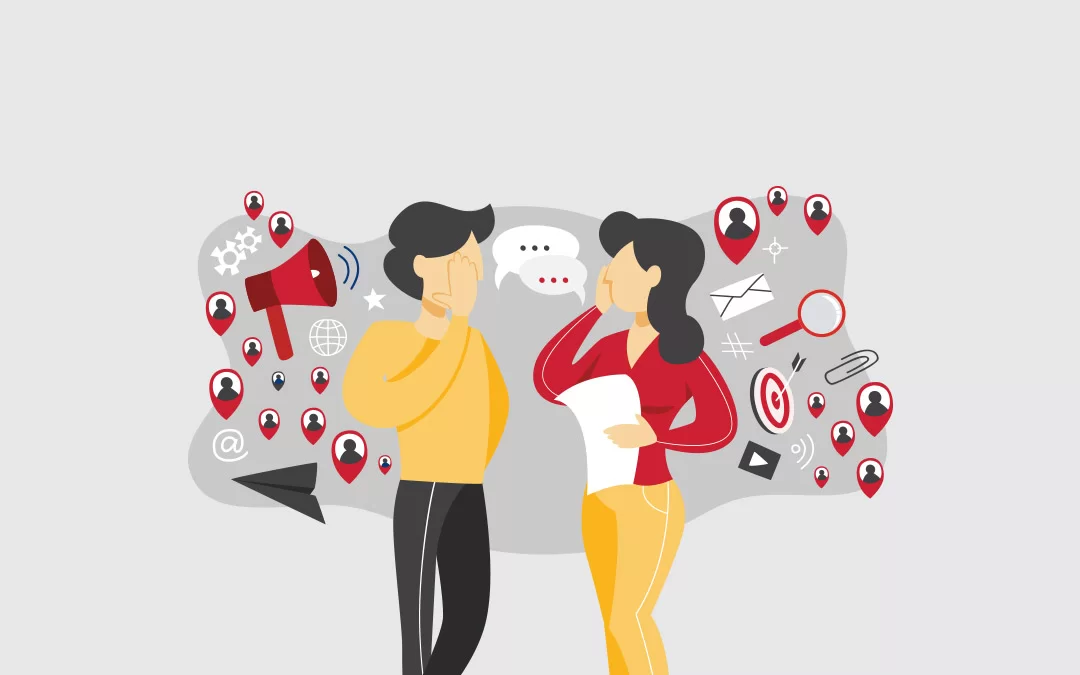What is Word-of-Mouth Marketing and Why is it Important?
Word-of-mouth marketing is how people talk about a brand, and information about a company spreads through casual conversations. Think about the last time something caught your eye, and you shared it with your friends. Have you ever liked the atmosphere and service of a coffee shop or restaurant so much that you tweeted about it or introduced it to your friends? Okay, you’re already familiar with the word of mouth marketing!
What is word-of-mouth marketing?
Word-of-mouth marketing is a new concept and a method that dates back many years! If you look carefully, there are many examples of this method in our memories, when your mother introduced a discount store to her sister, or your father got the address of an old car repair shop from his colleague, or even when you spoke about the quality of the restaurant you went to the night before. You ate dinner and talked with friends.
In all these examples, it is the word of mouth marketing that is going on. This simple method is so efficient and effective that today it occupies an essential part of the marketing budget of huge brands. But why is word-of-mouth marketing so important? Let’s take a closer look at this.
Let’s start with the figures. Surveys show that 92% of consumers believe a recommendation from a friend or acquaintance more than any other advertisement. This simple statistic reveals one of the most powerful truths in marketing: a company’s most significant marketing asset is its existing customers!
The amount of traditional and internet advertising is increasing every day. Companies spend huge budgets on advertising to attract new customers while ignoring the latent potential of their existing customers. In contrast, one of the most powerful techniques for profitability and customer acquisition is hidden in this area, the power of word-of-mouth marketing!
Why is a word of mouth marketing effective?
We like to talk. Telling about memories and recommending what we have experienced before gives us a sense of superiority. Therefore, if we have a solution to solve the problem of others, we will express it with pride! If this solution is a product or service from a brand, word-of-mouth marketing is formed. But implementing word-of-mouth marketing does not depend only on developing information flow from one side to the other.

The problem is not a lack of information because thousands of minutes of advertisements are aired on television daily to get the audience’s attention. The effectiveness of word-of-mouth marketing happens precisely on that flip side, where the audience decides to believe the information or not! Was it complicated? No problem. To examine this issue, let’s look at the formation of the idea of a purchase.
A close look at the purchase
Every purchase originates from some need. We analyze the market and find a product or service that can solve it, and now it’s time to choose. We have to choose one among different brands that offer products with the same function, and for this choice, first of all, we need information; As a result, the data collection process begins. Information collection sources are divided into two categories:
- Internal resources
- External sources
Internal sources are all the information we can access in our minds, such as previous shopping experiences, advertisements recorded in our memory, and everything we know about a particular product. But the external sources are where the information flows; External sources are also divided into two categories, both of which play a vital role in our purchasing decision:
Public sources include advertisements, newsletters, exhibitions, and information on product packaging.
Private sources include the recommendations and experiences of family, friends, acquaintances, and those with whom we are somehow connected; this is precisely where word-of-mouth marketing happens.
Public sources such as advertisements and announcements play the most critical role in transmitting information, but confidential sources are used to legitimize information. We get information through internet searches and social networks. Still, to believe it and factor it into our decision-making, we need a reliable source to confirm it here with Cornerstone. Word of mouth marketing: The power of trust!
It all comes down to one word: trust!
Let’s consider a simple scenario together. It would help if you had a toiletry bag. I’m a terrible salesperson, and I offer you a bag and say, “This bag is from a reputable brand, it’s great quality, and it’ll last you for years!” Can you wholeheartedly trust what I say?
Now consider another situation. It would help if you still had a duffle ba,g and this time I am one of your friends. When I understood your problem, I remembered my bag, and I recommend it to you like this: “This bag is from a reputable brand, it is of excellent quality and will work for you for years!”
Precisely the same sentences as before, but now you can trust the truth of what I said. After all, we have already met, and you do not doubt my intentions. Now that you’re happy to find a good one, you buy the bag at the first opportunity, and just like that, that brand gets a loyal customer for free!

With this scenario, we found that the actual effectiveness of word-of-mouth marketing revolves around one simple but decisive word: trust. Building trust in people is difficult, let alone when it is linked to business activities! But if companies can win the loyalty of their customers by continuously creating value, creating appropriate expectations, and acting on them, they will take several steps at once. Loyal customers are satisfied with their previous shopping experience, confident that the company’s products meet their expectations, and ultimately trust the brand.
Such customers voluntarily introduce the product to others and, even beyond that, consider the brand as one of their assets. Practical trust-building is beneficial but challenging. Everything we have said so far was from a situation where a satisfied customer recommends the product to another. But there is another side to this story, what if an unhappy or even angry customer shares his bad experience with others?
Word-of-mouth marketing is a double-edged sword!
You see an advertisement for an ice cream brand, An ice cream with a seductive appearance and a tempting taste, which attracts your curiosity. The next time you go to the store, you will buy several samples and bring them home, but after opening the first package, your sweet dream will come true! Not only is this ice cream’s appearance not similar to what is printed on the packaging, but the taste is not pleasing to the heart either!

In the advertisement, you were given a promise that was not fulfilled. What are you doing? You will probably be angry about your purchase, and for the next three days, every time the name of ice cream comes up, you will greedily say that that ice cream company deceived you and will never buy from them again. They say those who don’t learn from others’ experiences should learn from their failures! Undoubtedly, no one around you will buy from that brand again. Yes, word-of-mouth marketing is a double-edged sword.
Customer expectations
High expectations, if they are not met well, will hammer a nail in the coffin of companies! This is a lesson that every company should learn from the beginning; Making sweet promises and deceptive advertisements, if not supported by natural and valuable products and services, not only cannot guarantee more sales, but in the long run, they will damage credibility, profitability, and customer mindset.
One of the critical points in word-of-mouth marketing is this point; Sometimes, in conversations between people, the definition of a product is so exaggerated that it raises the expectations higher than the specific limit that the company has considered, and this can be not very reassuring for new customers who buy that product. This brings us to another critical point of word-of-mouth marketing: the difficulty of control.
Control
A company that encourages word-of-mouth marketing through its marketing practices (which we’ll cover later) has no control over what will be exchanged between audiences. This is one of the drawbacks of this technique. People can say whatever they want to their friends and audience verbally or online, and what is said is often not traceable or verified.

Word-of-mouth marketing is a modernized version of the 40 Crows. What goes first doesn’t necessarily match what reaches the last people! In addition to the issue of controlling the flow of talk about the product or service, the company cannot simply evaluate the effects of word-of-mouth marketing measures on sales and profitability and measure its effectiveness.
Cost
Word-of-mouth marketing is done at no cost to the company. If a customer is delighted with the product or service received, he will recommend it to his friends and acquaintances without additional incentives. In this way, word-of-mouth marketing can attract new customers even if the company does not spend much money on advertising programs. That’s why word-of-mouth marketing is especially suitable for small and local businesses with limited advertising budgets.
Which is tied to word-of-mouth marketing
Marketing activities are all tied together, and word-of-mouth marketing is no exception. The good thing about this issue is that you can take steps in several marketing tactics with a series of actions, and improving the strategy of each of these programs can positively impact other programs and the company’s primary marketing line in general. Word-of-mouth marketing is linked to several different concepts that we will mention below.
Rumor marketing
Word-of-mouth marketing focuses on getting customers to create and spread conversations about a product. This will increase brand awareness among the audience through online traffic. Influencers and critical figures in social networks fuel the creation of a rumor about a product or service and spread it by having a large audience.

This is typically done through high attention-grabbing tools such as video. Interestingly, positive rumors about a product spread quickly, but negative stories spread even faster! Of course, negative tales can damage the brand’s image if not controlled, so one must be very careful in creating and distributing the rumor.
Marketing blog
Blog marketing is introducing and promoting a product or service through a blog. In this concept, the blogger plays the role of an influencer or brand representative and provides content such as an introduction, reviews, and advertisements about the product and trend of his interest. After this stage, blogger followers are inclined towards the development and share the new information obtained with their friends, according to the type of communication and the style of their common interests.
network marketing
Posting content on social networks such as Instagram and Twitter is a way to reach people outside the leading network of the company’s audience. As we mentioned earlier, shared content is more effective if the content creator is someone you know and trust. This method is the core of many marketing methods, such as referral marketing.
How to design a word-of-mouth marketing strategy?
Now that we know how it works and the strengths and weaknesses of word-of-mouth marketing, it’s time to create an effective strategy. Considering what has been said, we know that creating word-of-mouth marketing is a sensitive activity, and a detailed plan is needed to achieve the necessary effectiveness. We want to know what moves a company can make to help create word-of-mouth marketing.
- Show your existing customers how much you appreciate them with small gifts that match your brand and product. For example, in the packaging of a coffee glass, Nestlé placed a large mug as a gift for customers, which was a good match for the product’s use.
- Create a compelling story about your company or products, About why you started your business, and why you believe in what you do. The report should be such that the audience would like to retell it.
- Create highly shareable content; Content that is useful, funny, or controversial, something that people will love to share.
- Make it easy to share content by developing the proper UI and buttons on your website.
- Create incentives for customers to share your content.
- Identify new customers who have joined your network through referrals and give them something extra besides the product purchased, such as a gift, discount code, or repeat purchase coupon.
- Organize special events for your customers and ask them to bring a friend to the event.
- Design an advertising campaign that gets people talking about your product and brand.
Building a business worth talking about
Of course, these techniques will work when you’ve built a business worth discussing. This means designing a respectful and lovable company, one that, at its best, customers consider a friend. How should you do this? Here are some ideas:
Remember the names. The more memorable and valuable a customer feels, the more inclined they are to tell others about their experience with your company.
Give them more than they expect. This could mean putting something small but free in every shopping bag to upgrade the level of service for no particular reason. Good surprises get people talking.
Add special features to your store. An aquatics store could add a wave pool, a shoe store could offer free food to every customer who tries on a shoe, or a bookstore could provide a dedicated printer to print a customer’s digital book.
Create an activity. This activity can be holding a workshop inside your store, a live presentation of a new product, or inviting a famous person to an event. Get customers excited about visiting your store and ask them to share what happened on social media.

Word-of-mouth marketing has existed since ancient times to introduce products and services. To this day, it can contribute to the profitability of companies and customer satisfaction through continuous value creation and creating a friendly relationship with customers. But this strategy comes into play when you enlighten your customers, create a delightful experience for them, and encourage them to help attract new like-minded customers.
What is your experience with word-of-mouth marketing? As a customer, has it helped you discover a good product? Has this method improved the sales and customers of your business?
We look forward to reading your story in the comments section, and you can also ask your questions or share this article with your friends!











